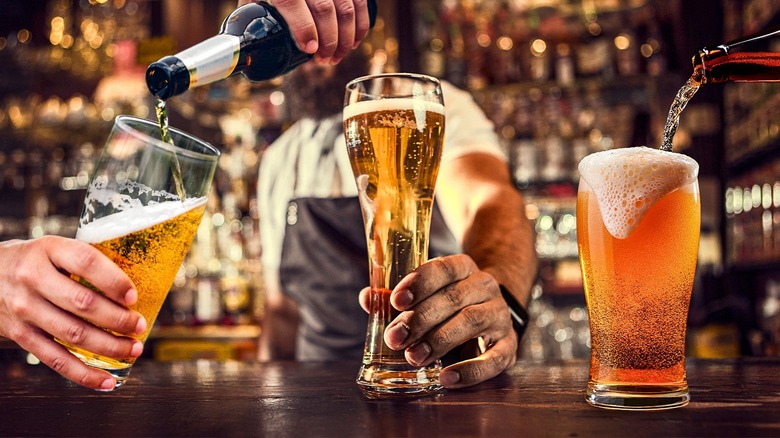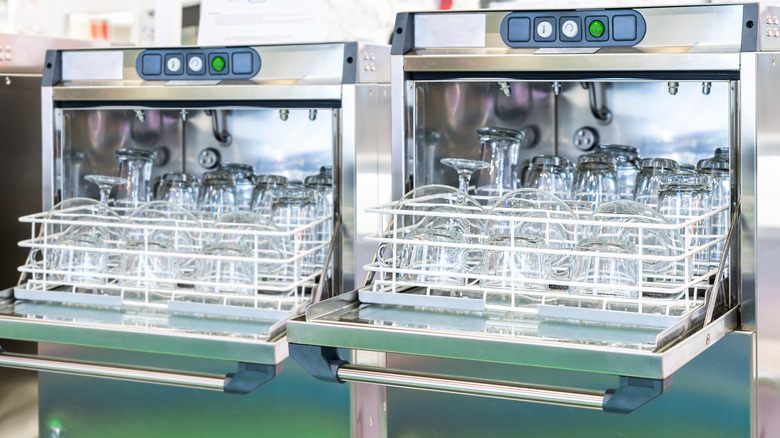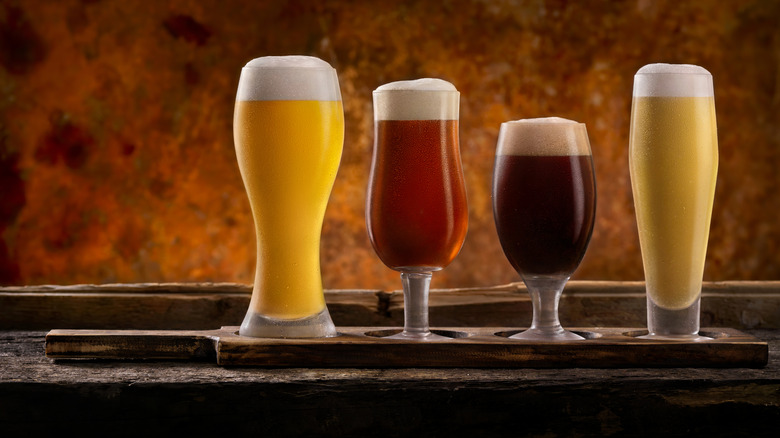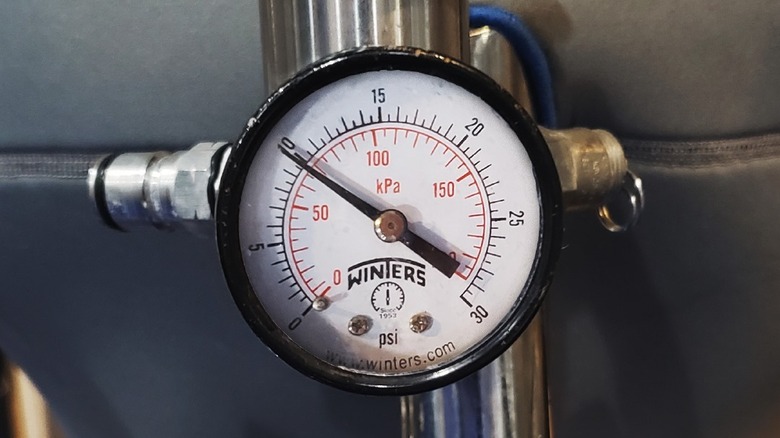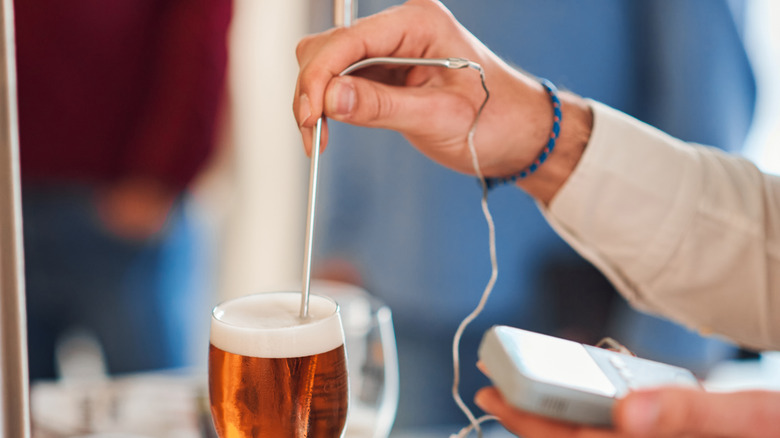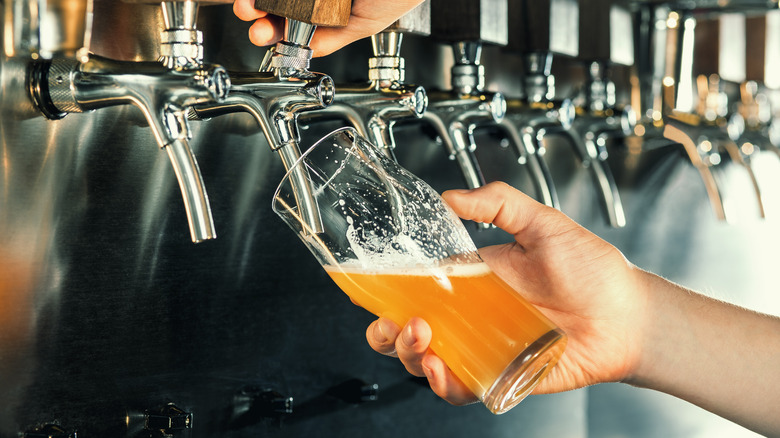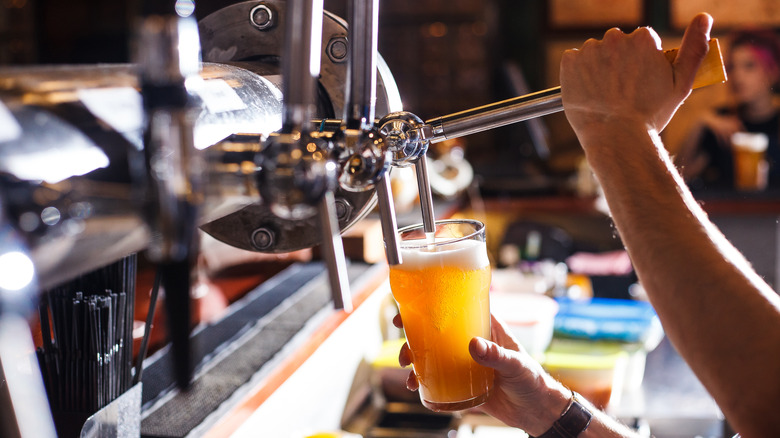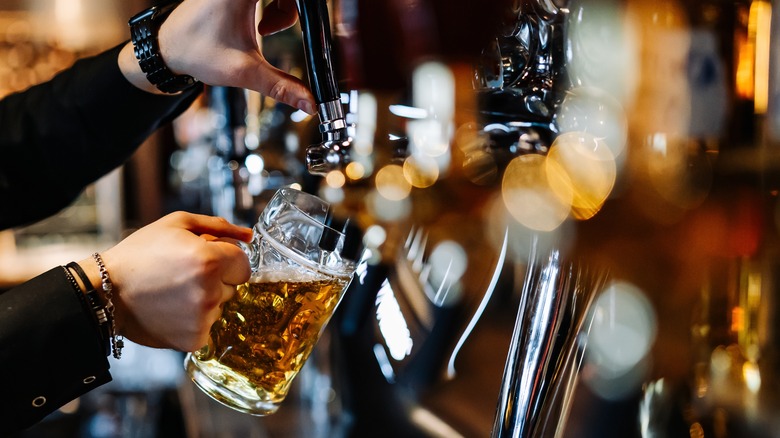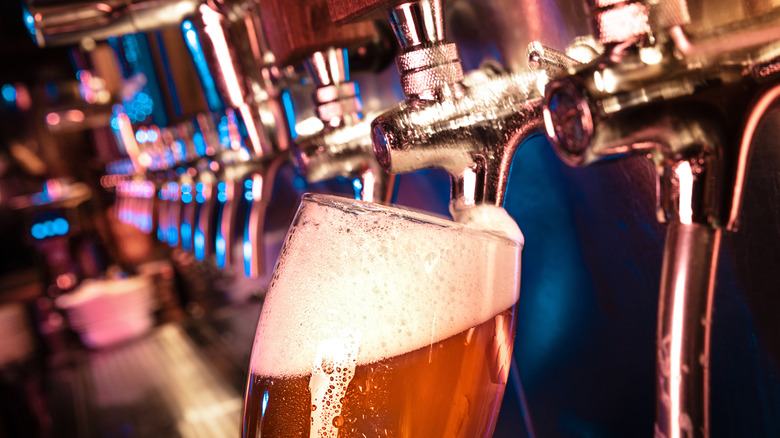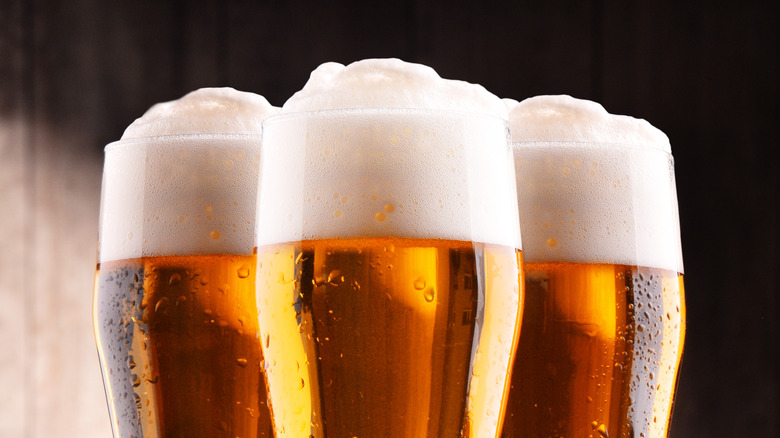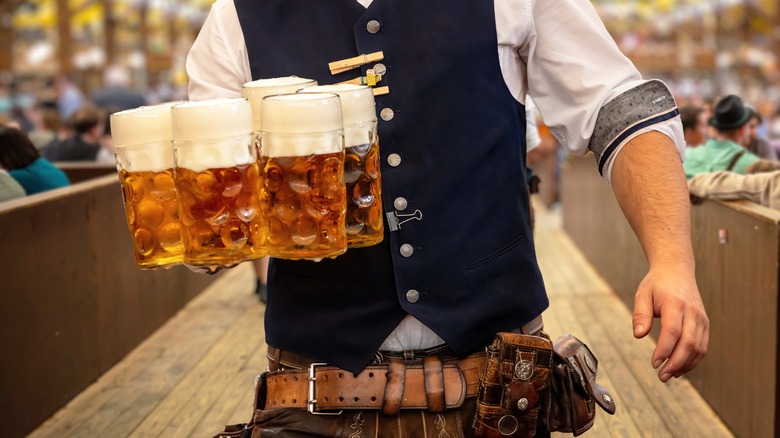11 Tips For Pouring Beer Like A Pro
Despite how common draft beer is, it's incredible how many establishments still struggle to get the basics right. Not only does the way a beer is poured have a huge impact on the final drinking experience, but it can also affect a bar's profitability, increasing revenue through more sales or reducing it via wastage.
Most major brewers even send employees to bars to train their staff, as it's the only way for them to guarantee the beer tastes like it should once it's left the brewery in a keg. I know this because testing and coaching bar staff were part of my responsibilities as an on-trade sales representative for Heineken. The brewery invested a huge amount of resources into training us in the science of beer and the perfect pour. Years later, I found myself managing a 24-tap brewpub for BrewDog, and had to become intimately familiar with running and troubleshooting draft beer systems while maintaining pouring standards throughout the staff.
Over the years, I've heard and followed just as much bad advice as I have good, combining the wisdom of master brewers with sheer trial-and-error to learn how to pour every style of beer as efficiently as possible ─ while maintaining the highest level of quality. These tips cover the most crucial aspects of pouring the perfect beer, and although there's no replacement for experience, the steps below are a solid foundation for learning to pour like a pro.
Check your glass is beer clean
Before we think about pouring beer, it's essential we start with a clean glass. While a dirty glass has obvious implications in terms of hygiene and visual appeal, there are several other issues that arise from using an unclean vessel.
Any residual elements in the glass have a chance of impacting the taste and aroma of the beer, and while it may still be palatable, it won't taste the way the brewer intended. The proteins in beer are crucial as they play a part in forming and maintaining the foamy top; something known as "head retention." We'll cover the importance of head retention shortly, but for now, it's important to know that residue within the glass will stop these proteins from forming a tight, creamy head.
Even the smallest particles in a glass can impact carbonation (the fizziness of the beer). Carbon dioxide interacts with imperfections on the glass in a process called nucleation which causes bubbles to form where we don't want them. This leads to excessive fizz and a loss of carbonation.
Fortunately, there are a few tricks we can use to identify a dirty glass. Aside from a visual inspection for things like lipstick marks or fingerprints, we can pour a beer and check if bubbles are forming on the outside of the glass. We can also rinse a glass with water and coat the inside with salt, which won't adhere to surfaces where there are residual fats and oils.
If your glasses aren't clean, fix the issue as soon as possible
It's not uncommon to encounter a dirty glass now and again, which isn't a problem if you know how to identify one before you start pouring. However, if the majority of your glassware isn't up to par, the culprit is likely your glasswasher.
First, it should be noted that a glasswasher should only ever be used to wash glasses. Anything that's had contact with food needs to be washed separately, as the fats and oils will build up and coat the glassware, and leftover food waste can impart unwanted flavors and aromas. The same goes for coffee mugs and tea cups, as the oils from the coffee and fat from the milk will also taint your beer glasses.
If your glassware isn't coming out clean, check that you're using the right cleaning chemicals and that they're topped up. Although not every glasswasher is the same, most require some form of detergent for the cleaning stage, and a rinse aid to help the glasses dry without water spots. It's also important to keep your machine replenished with dishwasher salt to prevent limescale, especially if you've got a hard water source.
Finally, it's best practice to use a glass refresher ─ the little fountains that spray the inside of a beer glass with water ─ before you pour. These remove any residue left from the glasswasher, and will rinse the dust from a glass that's been unused for a while.
Use the right glass for the job
Once you've ensured all of your glassware is "beer clean," the next step is to make sure you're using the right glass for the beer you're pouring. The shape and style of beer glasses are about more than aesthetics, and have a tangible impact on the drinking experience.
Many well-known beers have their own branded glasses, and you should use these whenever possible. Marketing reasons aside, brewers spend huge amounts of resources designing their glassware around their beer to promote specific aromas and manage carbonation. For example, while we mentioned unintentional nucleation earlier on, most lager glasses feature enamel markings on the base of the glass. This is done with the express purpose of agitating the carbon dioxide in a controlled manner to create a steady stream of bubbles.
For most ales, a standard pint glass will suffice, but light lagers usually call for pilsner glasses to promote carbonation and allow for a frothy head. Some beers, especially Belgian ales, call for a tulip or chalice-style glass, as their bulbed shape helps capture the intricate aromas, while the stem prevents the drinker's hand from warming the beer as they drink it. For sampling bold, complex beers, there's no better choice than a Teku glass; a wine glass-inspired vessel crafted specifically with beer tasting in mind.
Ultimately, it's worth researching which glasses pair with specific beer styles and ensuring you've got enough on hand for the beers you intend to serve.
Check your dispense system pressure
With our glassware taken care of, we now need to consider how our dispense system is set up. In layman's terms, the dispense system is what we call the infrastructure and equipment used to store and deliver the beer from the keg to the glass.
Excluding the hand pump systems used for cask ales, all dispense systems use either carbon dioxide, or a mixture of carbon dioxide and nitrogen, to move the beer from the keg through the beer lines ─ and getting the pressure level correct is crucial. If the pressure is too low, the beer will pour slowly, affecting your speed of service and making it harder to achieve a proper head. If the pressure is too high, you'll experience "fobbing," which is where the beer comes out of the tap as froth.
Most dispense systems allow you to adjust the pressure levels for each individual keg and beer line, which is important because different beers and keg types have varying requirements. For example, beers that require a higher level of carbonation and larger heads, such as German Hefeweizens, call for a higher pressure than smooth ales.
While stainless steel kegs have been the standard for decades and have the ability to withstand higher pressures, nowadays, it's not uncommon to encounter key kegs. These consist of a bag of beer within a pressurized plastic keg with the gas squeezing the beer from the outside, and subsequently can't withstand the same pressure levels as a steel keg.
Check your temperatures
The last thing to consider before we start pouring our beer is the temperature of the dispense system. Depending on the beers you're serving, there may be a few different stages of the system dedicated to attaining and maintaining the correct temperatures.
While there are some exceptions, most establishments that serve draft beer will have a dedicated cellar that should be kept between 11 and 13 degrees Celsius. Although this is sufficient for styles like Belgian or cask ales where we don't want to mute the complex aromas and flavors, most beers need cooling further. For these, the beer lines run through a remote cooler unit which brings the liquid down to around 3 to 7 degrees Celsius. Lastly, for beers that are served close to ice cold ─ typically mass-produced lagers ─ the liquid is cooled once more by a unit under the bar taps.
Temperature is crucial for a few reasons. First, we don't want to be serving flavorful beers too cold because of the negative impact on the taste and aromas. Beer that's too warm will also pour as foam, and is more likely to lose carbonation and come out flat, meaning the taste of alcohol may be more pronounced. Additionally, higher temperatures in the cellar will accelerate the aging process of the beer, resulting in unwanted off-flavors.
Hold the glass correctly
Now, we're ready to pour our beer. However, before we open the tap, we need to think about how we're holding our glass.
When it comes to serving drinks, one of the cardinal rules of hospitality is that the top two-thirds "belongs to the customer." What we mean by this, is that as a server or bartender, we should only be touching the bottom third of the glass to keep our hands and fingers away from the area close to where the customer puts their mouth.
So, after holding our glass by the bottom third, we then want to raise it at a 45-degree angle to the tap. The key is to get the nozzle as close to the inside of the glass as possible, but without ever letting the tap touch the glass or the beer. We'll cover more of the reasons behind this a bit later, but for now, we want to make sure the beer slides down the inside of the glass, slowly tilting the glass upright when it's half full. By the time the glass is straight, you should have about half an inch of space left which will allow the head to form on top.
We don't want to increase the distance between the beer tap and the glass too much, or else too much air will be introduced to the beer on its way down. This can lead to fobbing, and negatively impact head retention.
Open the tap fully
When our glass is in the 45-degree position and held close to the tap, we're ready to start pouring. However, you need to make sure you open the tap all the way.
Think of a hose pipe. If the hose is running and we pinch a section of it, the flow rate of the water slows down. However, simultaneously, the pressure increases to maintain equilibrium within the closed system. As we've already covered, neither of these are things we want when we're pouring beer. When the beer comes out too slowly, we're losing time and service slows down. The increased pressure and the restricted outlet will agitate the beer, resulting in excessive foaming that's not only a waste of beer, but also a waste of the time you'll have to spend on waiting for the beer to settle, or on pouring a new one.
Guaranteeing a correct and consistent flow rate helps preserve the aromatic compounds within the beer, as well as ensuring the correct amount of carbonation based on the particular style. If the tap is fully open and the beer is coming out too quickly, you'll want to go back to the cellar and adjust the pressure and flow controls until it starts to pour at the correct rate. It's also best practice to test the flow rate of an open line when you change kegs, especially if you're putting a different beer on that may have different flow and pressure requirements.
Don't move the glass while pouring
If you've ever watched draft beer being poured, you've almost certainly witnessed a bartender swirling the glass or raising and dropping it under the tap, ostensibly to create a head on the beer. While creating the perfect head is definitely important, this is not the way to do it.
To understand why, we need to look more closely at the role of gasses in beer. We already know that carbon dioxide is responsible for the mouthfeel and carbonation of the beer, while also enhancing the taste and aroma and contributing to good head retention. From a brewing perspective, the carbon dioxide produced by the yeast during fermentation plays a role in balancing the pH of the beer to prevent off-flavors. It also prevents oxygen from entering the beer which can result in oxidation, making the beer taste stale.
By moving the glass around when we're pouring, we introduce unwanted oxygen into the beer. While the beer won't oxidize in this short period, the added oxygen will reduce carbonation and impact the mouthfeel, making the beer taste flat. The lower carbonation will also mute the beer's flavors and aromas. If excess air is being added to the beer, that same air is being consumed by the drinker, which often results in feeling bloated. Aside from being an unpleasant sensation, a bloated customer is less likely to order another beer, which will chip away at the potential profits for a business.
Keep the tap nozzle out of the beer
Earlier, we mentioned that the nozzle of the beer tap shouldn't touch the glass or the beer while you're pouring. It's important to understand the reasons why, especially as some argue ─ incorrectly ─ that it's the best way to force a head onto a beer.
Technically, inserting the nozzle into the beer does create more foam by disturbing the surface of the liquid and releasing more carbon dioxide; however, this comes at a cost. As well as releasing carbon dioxide ─ in many cases too much, resulting in over-foaming ─ inserting the nozzle is likely to introduce excess oxygen, which we know is something to avoid. Direct contact between the nozzle and the beer also increases the risk of contamination. While the inside of the tap should be sanitary if your lines are being cleaned properly and on schedule, beer on the outside of the tap is the perfect breeding ground for unwanted microorganisms that we don't want entering our drink.
The sole exception for letting the tap enter the beer is if you're using a cask ale beer engine with a swan-neck nozzle. Unlike keg systems, cask ales continue to ferment in the cask, meaning they rely on natural carbonation without the need for external gas cylinders. As they only require low pressure for pouring, the risk of over-carbonation is minimal compared to high-pressure keg systems. Just make sure to wipe down the nozzle with a clean cloth between each pour.
Attain the perfect head
We've spoken a lot about the concept of head retention, so let's take a look at what makes a beer's head so important and the best way to get it right every time. The primary function of the head is to act as a barrier that keeps carbon dioxide in the beer and oxygen out, effectively trapping the carbonation for longer.
The head also helps retain the beer's volatile compounds, which are responsible for providing the aroma ─ a weak or non-existent head means these escape too quickly to be enjoyed to their fullest. Additionally, the mouthfeel of a tight, creamy head is a key part of the sensory experience of drinking a beer, and when it hits our taste receptors, can balance out overly sweet or bitter flavors thanks to the proteins within. As a rule of thumb, the head of a beer should take up at least 5% of the glass; however, some beers, such as Belgian ales or German wheats, traditionally call for much thicker heads.
We've covered a lot of ways you shouldn't try to create a head on a beer, and the truth is, if your glass is clean and your system set up properly, simply pouring the beer correctly should give you a proper head. If you do need to add more head to the beer, this is where you can partially open the tap to top up the foam, and some taps can be pushed forward for the same result.
Serve the beer as soon as possible
After you've poured a beer, you want to get it in the hands of the customer as soon as you can. Once the liquid is out of the chilled beer lines, it will start to get warmer and taste less refreshing.
High-quality beers that have been poured properly in clean glassware will have good head retention, meaning the head hangs around for longer, but it won't last forever. As the head disappears, the aromas and carbonation will also begin to fade, resulting in a less-than-stellar drinking experience. If you find this happening, it's a strong indicator that service is becoming too slow to guarantee all of your customers are happy.
There are times when serving beer quickly is hampered by factors that are out of your control, like a customer ordering a huge round, or having to change a keg mid-service, but there are ways to make sure the beer keeps flowing at a smooth pace. For large orders, you can either break the round into sections, or pour the whole round and leave space at the top for the head so you can top them up quickly before serving. For busy, high-volume bars, a runner is indispensable ─ someone who can take drinks out as soon as they're ready, and handle things like keg changes or cellar troubleshooting, while the bartenders keep pulling pints.
